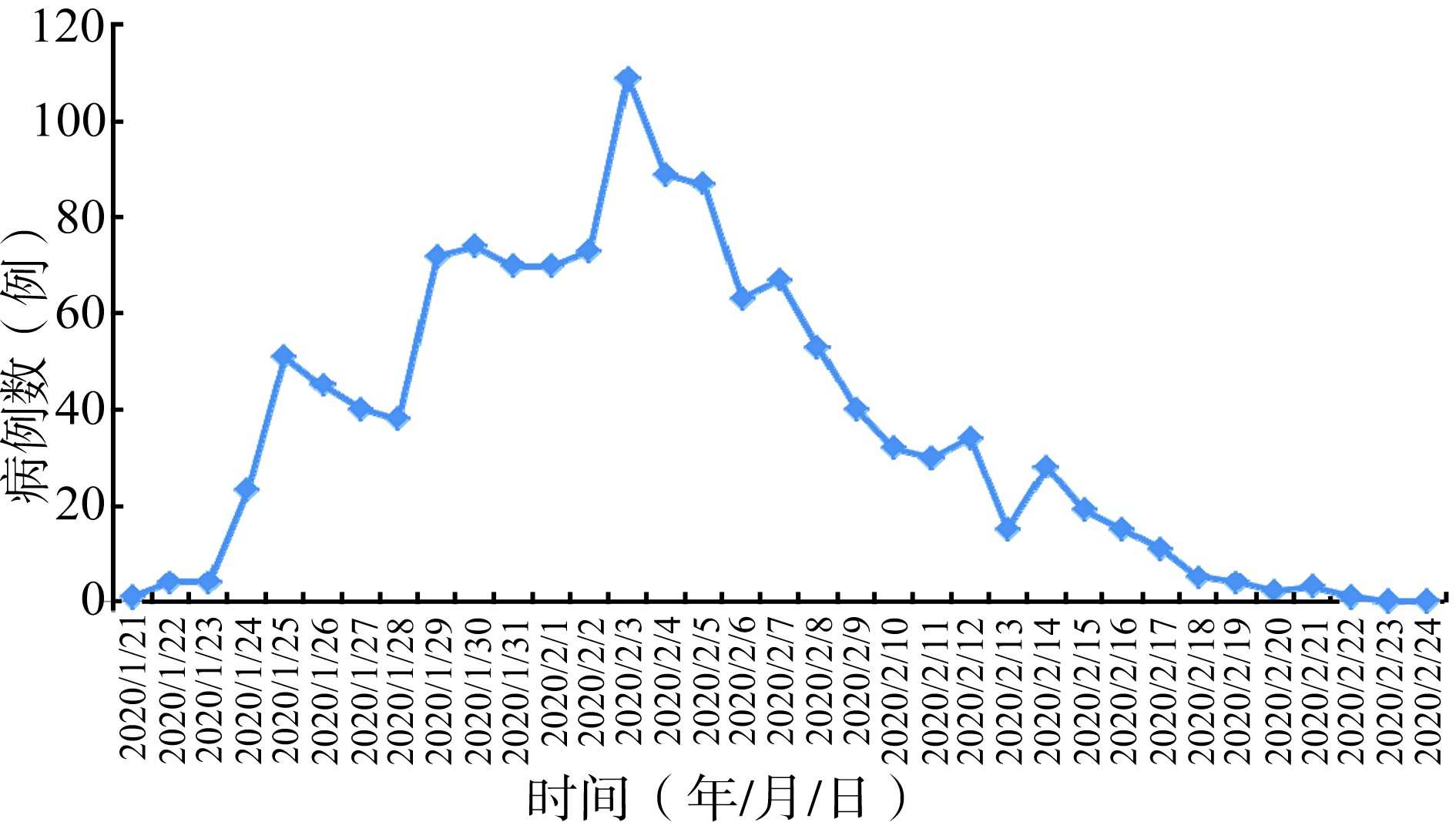-
摘要:
目的 利用地理信息系统(geographic information systems, GIS)探索河南省新型冠状病毒肺炎(coronavirus disease 2019, COVID-19)空间分布规律。 方法 收集河南省新型冠状病毒肺炎报告数据, 建立GIS数据库, 应用空间相关分析软件(GeoDa 1.8.12)和时空扫描软件(SaTScan 9.4)对数据进行空间自相关分析和时空扫描统计分析。 结果 河南省COVID-19存在空间聚集性; 5个时段共探测到50个高-高聚集区; 时空扫描统计分析共识别到5个时空聚集区。 结论 河南省COVID-19传播风险经历了弱-强-弱的变化过程, 采取的应急防控策略不但阻止了疫情在时间上的增长, 还有效遏止了其在空间上的扩散。 Abstract:Objective To explore the spatiotemporal distribution pattern of coronavirus disease 2019(COVID-19) in Henan Province using geographic information systems(GIS). Methods Epidemiological data of COVID-19 were collected, and relevant GIS data bases were established. The global and local indicators of spatial autocorrelation analysis was carried out by GeoDa 1.8.12 software, and SaTScan 9.4 software was used to describe the spatiotemporal scan statistics. Results A total of 50 regions of high-high aggregation by local spatial association analysis observed in in Henan Province; five statically significant COVID-19 clusters were identified by the retrospective spatiotemporal scan. Conclusions The risk of COVID-19 transmission in Henan Province has experienced a process: from weak to strong, then to weak. The emergency strategies not only prevent the growth in time, but also effectively prevent its spread in space. -
表 1 河南省新冠肺炎GSA Moran's I指数
Table 1. The Moran's I of COVID-19 in Henan Province
时间(月/日) Moran's I值 Sx Z值 P值 是否聚集 1/21-1/27 0.128 4 0.033 2 4.039 6 0.003 是 1/28-2/3 0.353 1 0.035 5 10.102 8 0.001 是 2/4-2/10 0.307 0 0.035 4 8.871 3 0.001 是 2/11-2/17 0.226 0 0.034 6 6.697 4 0.001 是 2/18-2/24 0.090 7 0.033 9 2.855 4 0.020 是 1/21-2/24 0.432 8 0.034 5 12.707 2 0.001 是 表 2 河南省新冠肺炎时空扫描统计结果
Table 2. The result of spatiotemporal scan statistics for COVID-19 in Henan Province
聚集区 时间(月/日) 中心点(经、纬度) 半径(km) 县区数(个) 病例数(例) 期望数 RR值 LLR值 P值 1 1/29-2/9 32.38N, 113.43E 154.92 38 409 113.54 4.81 269.41 < 0.001 2 1/31-2/9 34.75N, 113.61E 18.21 7 67 19.61 3.55 35.82 < 0.001 3 1/27-2/11 36.09N, 114.36E 0.00 1 23 3.26 7.17 25.37 < 0.001 4 1/30-2/3 34.24N, 116.13E 79.34 9 48 14.34 3.44 24.78 < 0.001 5 2/3-2/11 34.68N, 112.47E 4.41 2 12 1.43 8.49 15.04 0.006 -
中华人民共和国国家卫生健康委员会.国家卫生健康委办公厅关于印发新型冠状病毒肺炎防控方案(第五版)的通知[EB/OL]. (2020-02-21)[2020-02-22]. http://www.nhc.gov.cn/jkj/s3577/202002/a5d6f7b8c48c451c87dba14889b30147.shtml.National Health Commission of the People's Republic of China. Notice of the national health commission on the issuance of COVID-19 prevention and controlplan(Version 5)[EB/OL]. http://www.nhc.gov.cn/jkj/s3577/202002/a5d6f7b8c48c451c87dba14889b30147.shtml. Chan JF, Kok KH, Zhu Z, et al. Genomic characterization of the 2019 novel human-pathogenic coronavirus isolated from a patient with atypical pneumonia after visiting Wuhan[J]. Emerg Microbes Infect, 2020, 9(1): 221-236.DOI: 10.1080/22221751.2020.1719902. Hang C, Wang Y, Li X, et al. Clinical features of patients infected with 2019 novel coronavirus in Wuhan, China[J]. Lancet, 2020, 395(10223): 497-506.DOI: 10.1016/S0140-6736(20)30183-30185. 廖星, 周军, 曹佳, 等.新型冠状病毒肺炎与细菌性肺炎的胸部CT特征比较[J].武汉大学学报(医学版), 2020, 3: 1-4.DOI: 10.14188/j.16718852.2020.0086.Liao X, Zhou J, Cao J, et al. Chest CT features comparison between COVID-19 and bacterial pneumonia[J]. Med J Wuhan Univ, 2020, 3: 1-4. DOI: 10.14188/j.16718852.2020.0086. 古敏, 刘娇, 史楠楠, 等.中医药分期防治新型冠状病毒肺炎的药性功效分析[J].中国中药杂志, 2020, 3: 1-8.DOI: 10.19540/j.cnki.cjcmm.20200225.501.Gu M, Liu J, Shi NN, et al. Analysis of property and efficacy of traditional Chinese medicine in staging prevention and treatment of Coronavirus disease 2019[J]. China J Chin Mater Med, 2020, 3: 1-8. DOI: 10.19540/j.cnki.cjcmm.20200225.501. 中国疾病预防控制中心新型冠状病毒肺炎应急响应机制流行病学组.新型冠状病毒肺炎流行病学特征分析[J].中华流行病学杂志, 2020, 41(2): 145-151.DOI: 10.3760/cma.j.issn.0254-6450.2020.02.003.Epidemiology Working Group for NCIP Epidemic Response. The epidemiological characteristics of an outbreak of 2019 novel coronavirus diseases(COVID-19)in China[J]. Chin J Epidemiol, 2020, 41(2): 145-151. DOI: 10.3760/cma.j.issn.0254-6450.2020.02.003. Li Q, Guan X, Wu P, et al. Early transmission dynamics in Wuhan, China, of novel coronavirus-infected pneumonia[J]. N Engl J Med, 2020, 382(13): 1199-1207.DOI: 10.1056/NEJMoa2001316. 曹志冬, 曾大军, 郑晓龙, 等.北京市SARS流行的特征与时空传播规律[J].中国科学:地球科学, 2010, 40(6): 776-788. http://www.wanfangdata.com.cn/details/detail.do?_type=perio&id=zgkx-cd201006011Cao ZD, Zeng DJ, Zheng XL, et al. The epidemic characteristics and the rule of space-time transmission of SARS in Beijing[J]. Scientia Sinica: Terrae, 2010, 40(6): 776-788. http://www.wanfangdata.com.cn/details/detail.do?_type=perio&id=zgkx-cd201006011 Kulldorff M, Nagarwalla N. Spatial disease clusters: detection and inference[J]. Stat Med, 1995, 14(8): 799-810.DOI: 10.1002/sim.4780140809. 缪丹丹, 张芹, 孙中明, 等.基于地理信息系统的淮安市食管癌发病时空统计分析[J].中华疾病控制杂志, 2019, 23(9): 1097-1101.DOI: 10.16462/j.cnki.zhjbkz.2019.09.016.Miao DD, Zhang Q, Sun ZM, et al. Spatiotemporal analysis of esophageal cancer incidence in Huai'an: a study based on geographic information system[J]. Chin J Dis Control Prev, 2019, 23(9): 1097-1101. DOI: 10.16462/j.cnki.zhjbkz.2019.09.016. Jacquez GM, Greiling DA. Local clustering in breast, lung and colorectal cancer in long island, New York[J]. Int J Health Geogr, 2003, 2(1): 3.DOI: 10.1186/1476-072x-2-3. Sasson C, Cudnik MT, Nassel A, et al. Identifying high-risk geographic areas for cardiac arrest using three methods for cluster analysis[J]. Acad Emerg Med, 2012, 19(2): 139-146.DOI: 10.1111/j.1553-2712.2011.01284.x. -





 下载:
下载:



